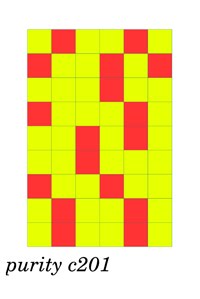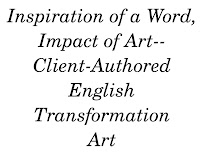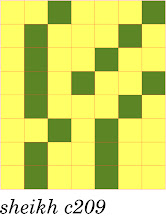The code I use to make English Transformation Art can be viewed as the logical function called "toggle". Starting at logical zero, one strobe causes a change to one. A second strobe causes a change back to zero. So if we represent each strobe by a stroke, one stroke equals one and two strokes equals zero.
But we can do this for three or more strobes instead of two. In the case of three, we start at zero, then one strobe changes the value to one, a second strobe changes the value to two, and a third strobe changes the value back to zero. This is a toggle, a tri-toggle, if you will.
Four would be analogous--a quadritoggle.
The set of all such toggles we could call "polytoggles".
Polyhedrons begin at the four-sided tetrahedron. Polygons begin at the three-sided triangle. And now we have added polytoggles, which begin at the two-sided bi-toggle, making a sequence of three members which begin with four, three, and two sides. Polytoggles live in two dimensions--along a line. Call the runs of ones in a polytoggle a vertex, analogous to the vertex of a polyhedron or polygon. They are separated by a side, analogous to the side of a polygon. Irregular polytoggles have unequal sides, and regular polytoggles have equal sides. Another grade of regularity comes for a regular polytoggle when the distance between vertices is twice the distance between strokes in any vertex.
Polytoggles can be concatenated just like polygons and polyhedrons can. The set of concatenated double regular tritoggles includes the English Transformation Art forms.
Sunday, April 25, 2010
Thursday, April 8, 2010
A little theme about Clent-Authored English Transformation Art
For some people buying art is at its best when they can interact with the artist before making their purchase.
With Client-Authored English Transformation Art, interaction with the artist is first and foremost. There are thousands of words in the English language and to find the one that both works as ETA and satisfies the taste, ideals, and aspirations of the client is potentially a real adventure.
We often find ourselves in the position of choosing a word with great care. There are myriad ways we encounter such a situation, whether in personal correspondence, business affairs, or perhaps something more professional--poetry, stories, or plays. But in all of these cases, a single word can rely on a context of other words to perform its duties, since most writing is based on the sentence for meaning. The word is usually atomic. It is a basic unit that doesn't get broken down. Rather, it gets its usefulness by building up into large collections of units. English Transformation Art breaks the atom. Each letter is analyzed as a collection of three component units, breaking the alphabet down into successive three-tuplets until one gets down to an individual letter or the space. Then a code is applied to each three-tuplet. Before the code, the tuplets are the numbers zero, one, and two. The code transforms zero into three ones, one into one one, and two into two ones. Between each coded tuple is a zero. So...
"a" = ||| ||| |
"z" = || || ||
" " (the space) = ||| ||| |||
Unlike normal computer code, this code produces several different lengths of strings for the different letters. This variety results in a great variety of compositions when all the letters in a word are put into the code. The strings for each letter are just put together end to end to get the code for the word. But sometimes the total number of digits for a word is a prime number, so they don't make a nice rectangle. About half of words do make a nice rectangle.
The result is a work of art that truly represents the letters of a word, only broken down into three-tuplets, and then encoded. It breaks open the atom. Then, when it occupies a place on a wall in your home, office, or boardroom, the power of the atom is released as a work of art. The title appears, in English, discretely below the left corner of the work, and it is the word pictured in the artwork. (The bold word shown in the examples does not appear in the actual art.)
With Client-Authored English Transformation Art, interaction with the artist is first and foremost. There are thousands of words in the English language and to find the one that both works as ETA and satisfies the taste, ideals, and aspirations of the client is potentially a real adventure.
We often find ourselves in the position of choosing a word with great care. There are myriad ways we encounter such a situation, whether in personal correspondence, business affairs, or perhaps something more professional--poetry, stories, or plays. But in all of these cases, a single word can rely on a context of other words to perform its duties, since most writing is based on the sentence for meaning. The word is usually atomic. It is a basic unit that doesn't get broken down. Rather, it gets its usefulness by building up into large collections of units. English Transformation Art breaks the atom. Each letter is analyzed as a collection of three component units, breaking the alphabet down into successive three-tuplets until one gets down to an individual letter or the space. Then a code is applied to each three-tuplet. Before the code, the tuplets are the numbers zero, one, and two. The code transforms zero into three ones, one into one one, and two into two ones. Between each coded tuple is a zero. So...
"a" = ||| ||| |
"z" = || || ||
" " (the space) = ||| ||| |||
Unlike normal computer code, this code produces several different lengths of strings for the different letters. This variety results in a great variety of compositions when all the letters in a word are put into the code. The strings for each letter are just put together end to end to get the code for the word. But sometimes the total number of digits for a word is a prime number, so they don't make a nice rectangle. About half of words do make a nice rectangle.
The result is a work of art that truly represents the letters of a word, only broken down into three-tuplets, and then encoded. It breaks open the atom. Then, when it occupies a place on a wall in your home, office, or boardroom, the power of the atom is released as a work of art. The title appears, in English, discretely below the left corner of the work, and it is the word pictured in the artwork. (The bold word shown in the examples does not appear in the actual art.)
Thursday, March 25, 2010
ETA word suggestions may not work as ETA.
I point out that I may suggest words for ETA sometimes without doing the calculation of whether they will work out to a nice rectangle, and that is a requirement for producing the work. These suggestions are only intended to show the great variety of words that, if they work, would make a really nice keynote as ETA. Whether a word, or text, works out ok is totally random. About half of all words work. Same for longer texts.
Tuesday, March 2, 2010
Sunday, February 21, 2010
due diligence
I just came across, again, a word that I think a business or corporation would love to see hanging in its offices as English Transformation Art. It is "diligence." Or also, "due diligence."
Such a rich field of positive associations!!
And a good political move to have to show to clients who come into the office!
Such a rich field of positive associations!!
And a good political move to have to show to clients who come into the office!
Monday, January 25, 2010
The role of English Transformation Art in civilization
English Transformation Art is an odd beast. It is both language and art. How is it to be classified? Let me speculate.
Language use is judged for its movement on those mysteries of life which its foundation covets. Large movements get prime real estate on records. Small ones get shoved around. It makes good economic sense. Client-authored English Transformation Art is a modification of the terms in this economy. The real estate value of art combines with the client's pyramid of values in words, and the result is new territory.
Instead of word compostion, ETA is a work in the word meanings for their own sake, focusing on a text of maybe just one word because longer ones get too busy with data to serve as art, converting the letters into an immediately impression-like image that the mind processes logically to completion, not needing to focus on the many pathways of the lines that one gets with the letters themselves. The code has different lengths for different letters, so two words of the same number of letters will look completely different as ETA.
So ETA is art in impact, but language in import.
Language use is judged for its movement on those mysteries of life which its foundation covets. Large movements get prime real estate on records. Small ones get shoved around. It makes good economic sense. Client-authored English Transformation Art is a modification of the terms in this economy. The real estate value of art combines with the client's pyramid of values in words, and the result is new territory.
Instead of word compostion, ETA is a work in the word meanings for their own sake, focusing on a text of maybe just one word because longer ones get too busy with data to serve as art, converting the letters into an immediately impression-like image that the mind processes logically to completion, not needing to focus on the many pathways of the lines that one gets with the letters themselves. The code has different lengths for different letters, so two words of the same number of letters will look completely different as ETA.
So ETA is art in impact, but language in import.
Labels:
English Transformation Art,
language,
mysteries of life,
words
inaugural post
Welcome to the English Transformation Art blog of James Batek. This information was formerly located on my general blog, http:gettingyourbusiness.blogspot.com. Today is the first day of its separate existence, which is intended to make it more accessible for customers just interested in the art.
In the sidebar, all the most important information about purchase and how the work is created will be always available in one easily located place. That is where the Paypal buttons are, for when everything has been decided on the work.
The YouTube video in the sidebar gives a brief introduction to the whole process of this artform.
Thanks for visiting!!
In the sidebar, all the most important information about purchase and how the work is created will be always available in one easily located place. That is where the Paypal buttons are, for when everything has been decided on the work.
The YouTube video in the sidebar gives a brief introduction to the whole process of this artform.
Thanks for visiting!!
Subscribe to:
Posts (Atom)



